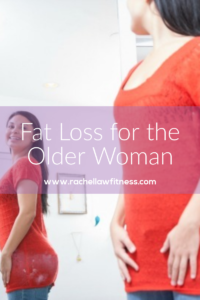Every woman knows how hard it is to lose body fat on the butt, thighs and belly. Sometimes it feels like fat loss is simply impossible!
However, it’s the abdominal fat that creates the greatest health risk to a woman. This abdominal fat seems to rear its ugly head when a woman reaches her mid- forties or peri-menopause (the years leading up to menopause).

Hormonal fluctuations brought on by lifestyle factors and menopause have a significant effect on a woman’s ability to fight weight gain. However it must be pointed out that absolute weight gain is determined first and foremost by non-hormonal factors such as poor nutritional habits and lack of regular exercise, and not menopause itself.
By the time a woman reaches her late thirties, she is starting to lose muscle mass. This loss of muscle mass speeds up a little each decade of life so when a woman reaches her forties, it is estimated she will GAIN about 500g of fat each ensuing year…..that’s a weight gain of 5kg every ten years!
Inactive women can lose up to 5% of muscle mass each decade. Active women will also lose muscle mass but at a much slower rate, especially if they maintain a regular weight training program.
A lack of muscle mass simply allows more room for fat cells to spread and take a strong hold. In other words, if you have more fat cells than muscle tissue, you will find it difficult to keep the weight off long-term without some form of regular strength training to help build muscle.
Muscle assists with fat loss as it helps to burn the fat…
The Oestrogen and Fat Gain Relationship
When a woman enters the mid-life years, oestrogen levels drop significantly and this hormone reduction has SOME influence on the belly bulge. Generally speaking, almost all women experience weight gain once oestrogen levels decrease with the onset of menopause.
A study on weight gain among menopausal women found that the way fat is deposited also changes as a woman enters menopause. The research showed there is a shift in a woman’s fat stores away from the hips and thighs to the abdomen, in women of all weight variances, from those women with a healthy weight to those who are heavily overweight.
Other Hormonal Factors which impact fat loss
HGH
When a woman approaches menopause not only is there a significant drop in oestrogen, there is also a decrease in levels of Human Growth Hormone or HGH. This is a hormone which helps prevent fat storage in the abdomen by encouraging muscle growth throughout the body.
Insulin Sensitivity
The role of insulin is to help the body utilise glucose efficiently for energy. After eating insulin rises quickly pushing blood glucose absorbed from the meal into the liver and muscle tissues. Any glucose that cannot be stored in the liver or muscles cells is stored in the fat cells.
A healthy liver will be more receptive to accepting glucose for storage. If the liver is full of toxins it will have less capacity to do so…..a good reason for cutting back on alcohol and other environmental toxins.
Muscles that are active will be able to utilise the stored glucose and so be able to store more. Hence the importance of using the muscles by exercising. Once the liver and muscle have absorbed as much excess glucose as they are able, the remaining will be stored in the fat cells.
Poor insulin sensitivity arises when the body has consistently high blood glucose levels as cells are unreceptive to accepting glucose from the bloodstream. The pancreas is forced to manufacture more insulin and then the pancreas becomes stressed. If left untreated, this condition often leads to the onset of Type 2 Diabetes.
During menopause, it is also common for women to experience insulin sensitivity.
How is Long Term Weight Control Possible After Menopause?
Fat loss is achievable for the older woman. However, keeping weight gain in check well before she reaches menopause is the most effective way to maintain a healthy body weight. A study team in the U.S. found that natural declines in energy expenditure during menopause makes weight loss extremely challenging for a woman.
Factors such as a drop in BMR or basal metabolic rate, appetite changes due to hormonal fluctuations, and the simple fact that the brain sends signals to eat when a woman has lost some body fat, all make it a challenge to lose weight for women in their mid-forties and onwards.
But all is not lost! Here’s how:
Key Steps To Successful Fat Loss for the Older Woman
Lift Weights
The more muscle you have, the more it will help the body to dissipate blood glucose and prevent laying down fat. Lift weights at least 3 times a week using moderate to heavy weights. For best results, the weight should be challenging to lift, but remain a weight that you can control throughout the exercise.
Lifting moderate to heavy weights will encourage the growth of HGH to keep women looking younger and slimmer. It will also improve your posture, improve your mood, give you more confidence and more strength, and give you more energy.
You can expect to get some muscle definition but there is absolutely no way on earth women can naturally bulk up to the extent of a male bodybuilder.
Lifting light weights will NOT be adequate to enhance muscle growth and burn unwanted fat.
Full-Body Movements
You will burn more fat by doing compound exercises that utilize the whole body in one movement. So instead of doing shoulder presses, combine a squat with your press to work both the upper and lower body. It will fast-track your overall fitness and general strength.
Eat More Protein
Exercising with weights regularly means your muscles need additional protein to help with muscle growth.
Most women commonly don’t eat adequate amounts of protein. When trying to lose body fat, many women drastically drop the carbohydrates in the misguided thinking they will lose weight. However, this way of eating only encourages more body fat.
Drastically lowering your intake of this readily accessible energy forces the body to hold onto existing fat stores making it even more difficult to shift the weight.
Increasing your daily protein intake to about 1 gram per kilo of body weight per meal will be adequate to encourage muscle growth and fat loss.
Protein will help keep you feeling full for longer throughout the day and it will also help reduce urges for sweet empty calories such as chocolate bars, ice cream and sticky buns etc.
Sources of good protein: lean red and white meat, deep sea fish, tofu, eggs, nuts, legumes, protein shakes.
Stay Away from Low-Carb Diets
A very low carb diet will do you more harm than good.
The body requires a healthy dose of calories (roughly about 2000 calories/day) to assist in raising your metabolic rate to help burn fat. Much of the daily calories come naturally from carbohydrates, the body’s easiest source of immediate energy.
Drastically cutting back on carbs simply makes you feel stressed, sends your cortisol levels sky high, and in turn ‘switches’ on the body’s fat storage capacity to full steam ahead!
A 2011 study revealed that a moderate reduction in carbohydrates produces better weight loss results than a severely restricted carb diet. Strict low carb diets simply send the wrong messages to your body.
The Right Way To Do Cardio (aerobic activity)
Women generally perform too much slow, easy-as-you-go aerobic exercise and not enough strength training. A fitness program of 2-3 days of cardio plus 3-4 days of weight training, combined with a healthy diet, will encourage muscle growth, and that means a slimmer waistline!
Low to medium intensity cardio activity will help burn fat only while you are performing that activity. Once you stop that activity your body stops burning up the fat. Higher intensity aerobic activity will help raise your BMR and keep it elevated throughout the day. This allows your body to burn energy more efficiently for longer.
However, because the mid-life woman is losing body mass more than a 30-something female, she needs to limit her exposure to high-intensity aerobic activity to about twice a week. Remember – strength training is now a key factor in weight loss not endless hours of aerobic activity.
Eat More Fresh Vegetables With Your Protein
These fresh foods will help detox the body naturally, give you added fibre, help promote good health and keep you looking younger.
Overall it will help reduce the impact of any body fat gain you may experience.
Caffeine/Sugar at Low Levels
Caffeine and sugary foods/drinks will quickly go on the abdomen as fat.
Instead, drink more green tea or fresh vegetable juices to help the body detox and speed up fat loss.
Take Omega-3
Either in supplement form or by eating foods high in Omega-3 such as canola oil and olive oil, avocados, nuts and seeds, deep sea fish such as salmon or tuna, and oily fish such as sardines or mackerel. Omega-3s are important for the growth and maintenance of all cells.
Conclusion
Weight loss or weight control for the mid-life woman is always going to be more of a challenge than it is for a much younger female. To maximise the gains from your fitness regime follow the steps outlined above and get moving and eating well.
Be patient with your new-found health plan. Quick results will never ever teach anyone – male or female- how to keep the weight off long term. For best results, the human body needs time to re-adjust to any new program.
However, if you are consistent with your eating and exercise habits the results you desire will soon become evident.
Weight gain at midlife is age-related, not due solely to menopause. But the hormonal changes a woman experiences as she enters menopause, certainly contribute to abdominal weight gain.

Rachel Law is a personal fitness trainer based in New Malden, Surrey. Qualifications: ActivIQ Level 3 Personal Training; Burrell Education Pregnancy Exercise Prescription; Burrell Education Advanced Pregnancy Wellness Practitioner; Burrell Education Advanced Post Natal Exercise Prescription; Burrell Education 3rd Age Women Optimal Health and Nutrition; Burrell Education Peri Natal Athlete; Burrell Education Pelvic Flow and Freedom; Olympic Weight Lifting; Premier Global Kettlebells; FIE Level Assessment and Mentoring



